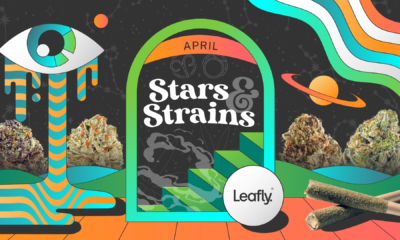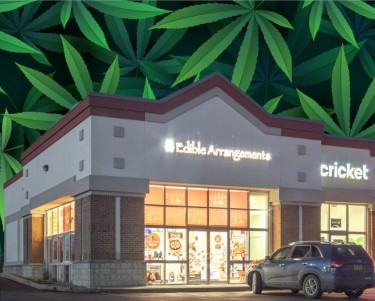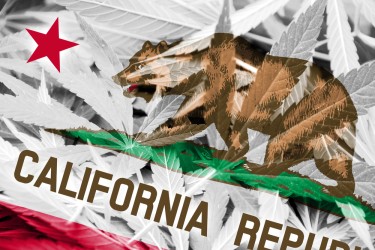Cannabis News
The Stealth Movement to Legalize Cocaine is Gaining Traction
Published
1 year agoon
By
admin

Why aren’t we leveraging our weaknesses in our favor?
Whenever I read headlines boasting about record drug seizures at sea, I don’t feel our society is winning anything. Rather, I see us gleefully throwing away millions that could benefit the public good.
Take for instance the recent interdiction of $500 million worth of cocaine and marijuana seized across 13 operations in the Caribbean and Eastern Pacific. Over 45,000 pounds confiscated, prevented from reaching consumer markets.
On the surface, authorities frame this as victory, keeping dangerous contraband off the streets. But consider the deeper implications.
That’s half a billion in potential tax revenue destroyed, enough to transform many lives through social programs. Instead, it’s sent literally up in smoke by prohibitionist ideology.
Even more ironically, the money will be wasted prosecuting and jailing the smugglers who were simply responding to customer demand. This endless game of cops and robbers squanders public funds.
Meanwhile, the cartels happily absorb the losses, comforted their immense profits remain intact. They even benefit from reduced market supply driving up prices.
So who really wins from this street value headline spree? Because it sure isn’t harm reduction or public interest.
Just imagine if we exploited our vices intelligently, regulating and taxing drugs to fund communities instead of criminals.
Those massive piles of seized powder could finance schools, rehabilitation, housing, healthcare, and youth programs. Addiction could be treated holistically.
We could even explore reparations for marginalized communities devastated by the war on drugs. The possibilities are immense.
But under prohibition, that utopian potential gets torpedoed and sent literally down the drain. When will we stop burning money and wasting human lives to target our own shadow? The system makes no sense.
Our weakness is ignorance of history, clinging to puritan myths about human nature.
Cannabis.net uncovered this movement at the Benzinga Cannabis Conference in Miami with an article entitled, “Cash Is King, Use Your Data, and Go Sell Legal Cocaine in Canada”.
Let’s break down what positive purposes $500 million in taxed drug revenue could serve our society, instead of literally going down the drain through seizures. That massive stack of contraband cash equates to immense potential public good.
For starters, it could provide 10,000 affordable housing units across the country, helping address chronic homelessness. No more veterans sleeping under highways or families on the edge of eviction. Stability for thousands.
Or we could fully revitalize multiple impoverished neighborhoods by investing in new infrastructure, schools, healthcare clinics, youth programs, green spaces and local businesses. Communities would transform from desperation to prosperity.
Imagine too if those funds went directly into drug rehabilitation, abuse prevention and mental health resources. We could support thousands getting clean while researching holistic alternatives to incarceration and empowering healthy communities.
That $500 million could also cover free community college tuition for 50,000 students. Imagine how many more would pursue higher education and well-paying careers without the burden of student debt. Knowledge shouldn’t be exclusive.
We could even dedicate $100 million towards direct monthly payments to single parents or caregivers to ease financial stresses. Parents already work harder than anyone. Let’s give them a hand up, not judgment.
Or consider medical applications. Half a billion could provide cancer treatment for 50,000 patients unable to afford it otherwise. The most vulnerable shouldn’t face death because of income. We have the resources in abundance.
The list is endless. Infrastructure, hospitals, green energy projects, small business grants, you name it. Almost any public need could be better served by regulated drug taxes than what the DEA is doing.
Clearly our society suffers not from a lack of funds but of imagination and compassion around using it wisely. We keep digging the hole of drug war waste deeper wondering why things don’t improve.
But the solutions are right there in front of us, if we muster the courage. End the charade of zero-tolerance. Embrace pragmatic harm reduction. Let human needs guide policy, not puritanical myths about eradicating desire.
The choice comes down to wasting more money destroying lives, or using that wealth intelligently to lift up lives. Our shared wellbeing hangs in the balance. 50 years of drug war has only bred more suffering. Isn’t it time we tried a society based on healing not punishment?
It’s true, drugs definitely have the potential to ruin lives when misused. But our policies around permitted substances versus banned ones reveals glaring hypocrisies.
Alcohol, for instance, kills over 95,000 Americans annually through health complications and drunk driving accidents. Tobacco claims over 400,000 lives a year via cancer, lung disease and other ailments.
Yet these two legal drugs account for more deaths than all illicit drugs combined – including notorious “hard drugs” like heroin and cocaine. Alcohol causes more societal harm through violence and addiction than any illegal substance.
The numbers don’t lie. CDC data shows alcohol contributes to around 11 million violent crimes annually, including murder, rape and domestic abuse. Meanwhile FDA-approved pharmaceutical opioids claim tens of thousands of lives in the overdose epidemic.
Clearly legality is no measure of a drug’s potential for harm. In many cases, the most dangerous substances on both a personal and societal level are sold over the counter.
So why do we accept such glaring double standards around certain drugs? What makes alcohol and tobacco intrinsically safer than cannabis, LSD or psilocybin – which have never caused a lethal overdose?
The answer lies less in pharmacology than morality. Our drug prohibitions derive more from political agendas and ingrained cultural bias than any scientific risk assessment.
Critics argue banning drugs is necessary because some individuals may ruin their lives. But this blanket justification could apply equally to cheeseburgers or skydiving or any number of potentially harmful but legally permitted activities we sensibly regulate for public safety.
A health-first approach recognizes adult freedoms while mitigating harm through education and support resources. It funds rehabilitation through reasonable vice taxes rather than jailing non-violent users.
We don’t have to ban peanuts outright because some children are allergic. Nor should we undermine civil liberties over puritanical notions of eliminating consensual adult activity with some potential downsides.
In a truly just society, policies arise from compassion not fear or judgment. We can deter harmful drug use through pragmatic health policies while respecting liberties. It simply requires shedding lingering prohibitive mentalities not grounded in facts.
Because the evidence shows virtually all drugs, like any substance, carry some risks and benefits depending on context. Blanket bans based on outdated cultural bias make no sense. A nuanced public health framework allows maximizing benefits while providing help to those who need it.
That $500 million drug seizure was just a fraction of the total US illicit drug profits we allow cartels to keep every year. The combined domestic market across all illegal drugs rakes in around $100-150 billion annually.
Let’s take the lowest estimate of $100 billion. Here’s just some of what we could fund if that black market operated above board and paid reasonable vice taxes:
-
20 billion towards drug rehabilitation programs, sober living facilities, mental health services, and community support. Helping those who need it most.
-
20 billion to community colleges and trade schools for free vocational training and higher education access. Investing in the next generation.
-
10 billion in grants for community projects like youth programs, food banks, battered women shelters, art spaces and more. Supporting vibrant, nurturing neighborhoods.
-
10 billion to house every homeless veteran and low-income family currently on the streets, because no one should face such indignity in a wealthy nation.
-
10 billion in small business grants for entrepreneurs from marginalized communities to spur economic mobility. Expanding opportunities.
-
10 billion for infrastructure upgrades to roads, broadband internet, green energy projects and public transit. Building toward the future.
-
5 billion in direct aid to single parents and caregivers struggling with childcare costs and unpaid labor. Recognizing their value.
-
5 billion for universal healthcare programs and subsidies for life-saving medications like insulin. Health is a fundamental right.
And this is just a fraction of what we could accomplish by regulating instead of prohibiting. We haven’t even touched large investments in schools, hospitals, nutrition programs, parks, conservation, scientific research and more. The possibilities are endless.
Yet we currently forfeit all this social potential by clinging to a failed criminalization model that causes more harm than any drug. Our choice fuels violent cartels when it could uplift our own communities.
Over $50 billion gets spent annually on drug law enforcement with little effect on supply or demand. But just a fraction of the overall market’s tax revenues could transform millions of lives for the better.
At a certain point we must confront reality – prohibition is an irrational policy failing by any metric.
The tide is clearly turning towards cannabis legalization in America, as evidenced by successive states adopting more enlightened policies even amidst federal foot-dragging. This momentum is encouraging.
However, the bigger issue remains dismantling prohibition across the board. As long as any consensual substances remain arbitrarily criminalized, excessive harms and wasted opportunity will persist.
Cannabis legalization is an important first step. But policy reform must not stop there. Entheogens, cocaine, opioids, and other demonized chemicals should be guided by humane pragmatism, not the antiquated absolutism of the drug war.
Because the core calculus remains – we currently forfeit at least $100 billion in potential annual revenue from regulated adult drug markets. Money that could uplift our communities through schools, healthcare, housing and more.
Yet we cling to a puritanical “zero-tolerance” ideology that only worsens problems. Over $50 billion gets spent annually on drug law enforcement, for negligible impact on supply or demand. Our own shadow remains unaddressed.
Does it make sense to keep wasting billions disrupting consenting adult activities that will never disappear? Especially when we could be generating wealth to help people and repair the damage from systemic oppression?
The drug war serves to prop up the corporate monopolies of Big Pharma, for-profit prisons, corrupt police unions, and the shadowy DEA itself. It must end for society’s greater good.
But change begins in our minds. We must shed the remnants of Reefer Madness propaganda and perceive drug regulation through the lens of pragmatic humanism, not dogma and fear.
Addiction and abuse can be better addressed through healthcare and education than handcuffs and intolerance. And responsible adult freedoms need not be constrained because some statistically will misuse them. Such is the nature of liberty.
The sticky bottom line is that prohibition is philosophically and economically irrational. Its cruelties serve only to divide society against itself. But pragmatic harm reduction fosters compassion, community, and optimal outcomes based on human needs.
The money and solutions are there when we muster courage. All that’s missing is the awakening to evolve past our own hypocrisies. But as old ways crumble, a more beautiful world unfolds.
THE MOVEMENT TO LEGALIZE COCAINE, READ ON…
IS THE LIGHT AT THE END OF THE WAR ON DRUGS LEGALIZING COKE?
You may like
-


White House Finally Comments On Marijuana Industry
-


Stop Using Bat Poop to Fertilize Your Weed Plants Immediately, Here is Why…
-


The History Behind April Fool’s Day
-


Star signs and cannabis strains: April 2025 horoscopes
-


Does Comfort Food Actually Help
-


Connect to cannabis history with three legacy strains from Paradise Seeds
Cannabis News
Stop Using Bat Poop to Fertilize Your Weed Plants Immediately, Here is Why…
Published
11 hours agoon
April 1, 2025By
admin

Don’t Fertilize Your Weed with Bat Poop
Fertilization is a critical step for growing healthy marijuana plants.
They help provide essential nutrients for marijuana in various stages of growth, while promoting plant growth. There are dozens of different fertilizers to choose from in the market; growers can choose based on budget, nutrients needed, location, season, and much more. But not all fertilizers are made equally – of course, some are of better quality than others.
That said, there are some rather unusual fertilizers that can be used on plants. These may include, but are not limited to: coffee, milk, grass clippings, banana peels, fish tank water, potato water, and even urine! Yes, it does sound strange, but to gardening enthusiasts, there is nutritional value to be found in each of these things, which can make them suitable fertilizers depending on the circumstances.
For example, grass clippings make excellent mulch and can provide potassium, nitrogen, and phosphorus. Urine is a potent source of nitrogen as well as phosphorus. Banana peels are rich in calcium, which is excellent for promoting root growth while helping supply oxygen to the soil.
But what about bat poop? Also known as guano, bat poop has been said to work as a plant fertilizer because it’s rich in nitrogen, potassium, phosphorus, and other nutrients. Unfortunately, using bat poop as a plant fertilizer can also be dangerous. So if you don’t really know what you are doing, bat poop as a fertilizer can be extremely risky.
Bat Poop Fertilizer Kills 2 NY Men
On December 2024, news of two men hailing from Rochester, New York, dying went viral.
The cause of death was dangerous fungus, in the bat poop that they were using to fertilize their marijuana plants. Both men grew their own marijuana plants for medical consumption, but unfortunately developed histoplasmosis after breathing toxic fungal spores from the guano.
One of the men was aged 59 years old; he bought bat poop online to use as fertilizer for his plants. Meanwhile, the other was a 64-year-old male who found guano in his attic, then decided to use it to fertilize his cannabis plants. They both developed similar symptoms, including chronic coughs, fever, severe weight loss, and respiratory failure. The case was also discussed in the Open Forum Infectious Diseases medical journal.
Is there a safe way to use bat poop as fertilizer? If you ask me, I truly can’t understand why one would use guano as fertilizer when there are so many other proven safe alternatives out there that are simply not as risky. According to the University of Washington, one must always wear a dust mask each time you open a bag containing soil amendments. That’s because a mask will greatly decrease the chances of breathing in fungal spores, which could be potentially dangerous. They also go on to explain that yes, guano is indeed used as fertilizer for its valuable nitrogen content but it still isn’t without its own risks, particularly of developing Histoplasma – the same condition that killed the two men.
Make Your Own Safe Fertilizers At Home
There are many other safe, affordable – and even free – fertilizers you can feed your marijuana plants with. It doesn’t have to cost a fortune nor does it have to be risky to your health.
Check out these easy, low-cost, DIY fertilizers for weed:
-
Coffee grounds are abundant in nitrogen, which makes it perfect for the vegetative stage of marijuana plants. They are also a fantastic source of organic materials and green waste, which contain other vital nutrients. When the coffee grounds decompose, they create soil aggregates that improve soil aeration and its water retention capabilities.
Mix around 2 grams of coffee ground for every liter of soil. Measuring its pH levels is also helpful, since you want it to be between 6 to 6.5
-
Crushed eggshells are a great way to ensure no eggshells go to waste. It’s rich in calcium plus other minerals that are effective in improving overall plant structure, health, and growth. In fact, so many gardeners and farmers commonly use crushed eggshells to help boost plant growth – and it will work just as well for marijuana plants.
They’re really easy to use, too! Just mix eggshells into the soil, or steep them into water then pour into the soil for a calcium-packed feed.
-
Banana tea or water is rich in potassium and magnesium, making it perfect as a feed during the marijuana plant’s flowering stage. You can use banana peels differently: with 3 to 5 banana peels, soak it in water for 2 days. Then you can use the water on your plants, and even leave the banana peels as compost for your garden.
-
Wood ash from your fireplace or other sources is a great source of phosphorus and potassium. Simply sprinkle some wood ash over marijuana during the final flower phase. Just use 1 or 2 grams of ash for every liter of substrate. Be careful not to use too much wood ash, or it can make the soil too alkaline.
-
Animal manure, such as those from cows, rabbits, or horses, make excellent organic fertilizers. Just be sure that they’re composed properly so that you avoid introducing weed seeds, or pathogens.
These low-cost fertilizers are also natural and effective. There’s no reason for you to turn to bat poop as fertilizer, even if you’re in a bind.
Conclusion
Guano or bat poop is a poor choice of fertilizer if you don’t know what you are doing. It’s risky and potentially dangerous – just not worth it. Instead, fertilize your marijuana plants with these options mentioned.
BEST POOP FOR CANNABIS PLANTS, KEEP READING…
Cannabis News
Getting THC Edibles in Your Edible Arrangement?
Published
2 days agoon
March 30, 2025By
admin

Edible Arrangements Leans into Intoxicating Hemp Products: A Strategic Expansion
Edible Arrangements, a brand renowned for its vibrant fruit bouquets and sweet treats, is embarking on a bold new venture into the hemp and THC-infused edibles market. Through its parent company, Edible Brands, the company has launched Edibles.com, an e-commerce platform offering a variety of hemp-based products such as THC-infused beverages, gummies, and snacks. This strategic move taps into the burgeoning demand for cannabis-related wellness products and reflects a deliberate expansion beyond traditional offerings.
Introduction to Edible Arrangements and Its New Venture
Edible Arrangements was founded in 1999 by Tariq Farid, who envisioned a unique way to gift fresh fruit arrangements that were both visually appealing and delicious. Over the years, the company has grown to become a global brand with hundreds of locations across the United States and internationally. However, the company’s latest initiative marks a significant departure from its traditional fruit-based offerings, signaling a broader strategic shift towards becoming a comprehensive food, health, and wellness company.
The New Venture: Edibles.com
Edibles.com debuted on March 20, 2025, starting operations in Texas with ambitious plans to expand rapidly across Southeastern states like Florida and Georgia. The platform is designed to cater to consumers aged 21 and older, providing low-dose THC products that comply with the 2018 Farm Bill, which legalized hemp containing less than 0.3% THC by dry weight. Select products will also be available for nationwide shipping where legally permitted, leveraging the company’s existing logistics infrastructure.
Product Lineup
The initial product lineup includes a range of THC-infused beverages, gummies, and snacks. These products are designed to appeal to both seasoned cannabis users and newcomers looking for low-dose, accessible options. The company emphasizes the importance of quality and safety, ensuring that all products undergo rigorous testing to meet high standards of purity and potency.
Strategic Alignment and Market Potential
The move into the infused edibles market aligns with Edible Brands’ vision of becoming a broader food, health, and wellness company. CEO Somia Farid Silber highlighted that the infused edibles market is a fast-growing sector with high consumer demand for safe and reliable products. The company is leveraging its extensive franchise network to deliver these items while planning to open brick-and-mortar stores under the Incredible Edibles brand.
Market Trends and Consumer Demand
The cannabis industry, particularly the segment focused on hemp and THC-infused products, has seen exponential growth in recent years. This growth is driven by increasing consumer interest in wellness and recreational products, as well as evolving legal landscapes that have opened up new markets. Edible Arrangements is positioning itself to capitalize on this trend by offering products that cater to both health-conscious consumers and those seeking unique gifting options.
Challenges and Opportunities
While this expansion offers significant growth potential, it also comes with challenges such as navigating varying state regulations and ensuring product safety and quality. The company aims to address these issues through robust infrastructure and consumer advocacy. Thomas Winstanley, a cannabis industry veteran leading Edibles.com, emphasized the company’s unique position to drive innovation in this emerging market.
Regulatory Challenges
One of the primary challenges facing Edible Arrangements is the complex regulatory environment surrounding cannabis products. Laws regarding the sale and distribution of THC-infused products vary significantly from state to state, requiring the company to adapt its operations to comply with local regulations. This includes ensuring that products meet specific THC content limits and are marketed responsibly.
Quality Control and Safety
Another critical challenge is maintaining high standards of quality and safety across all products. Edible Arrangements is investing heavily in testing and quality assurance processes to ensure that all products meet stringent safety standards. This includes partnering with reputable suppliers and implementing rigorous testing protocols to verify the potency and purity of all THC-infused items.
Consumer Education and Advocacy
As part of its strategy, Edible Arrangements is also focusing on consumer education and advocacy. The company recognizes that many consumers are new to cannabis products and may have questions about usage, dosage, and safety. To address this, Edibles.com will provide comprehensive product information, dosage guidelines, and resources for consumers to learn more about the benefits and risks associated with THC-infused products.
Marketing Strategy
Edible Arrangements plans to leverage its existing brand recognition and customer loyalty to promote its new line of hemp-based products. The company will utilize social media, email marketing, and targeted advertising to reach its target audience. Additionally, partnerships with influencers and cannabis industry experts will help build credibility and drive awareness about the brand’s entry into this new market.
Future Expansion Plans
In the coming months, Edible Arrangements plans to expand its operations beyond Texas, targeting key markets in the Southeast. The company is also exploring opportunities to open physical stores under the Incredible Edibles brand, which will offer a curated selection of THC-infused products alongside traditional Edible Arrangements items.
Incredible Edibles Stores
The Incredible Edibles stores will serve as a unique retail experience, combining the company’s traditional fruit arrangements with its new line of hemp-based products. This format will allow customers to explore and purchase THC-infused items in a welcoming and educational environment. The stores will also host workshops and events focused on cannabis education and wellness, further enhancing the brand’s position as a leader in this emerging market.
Conclusion
Edible Arrangements’ foray into the hemp and THC-infused edibles market marks a significant strategic shift for the company. By leveraging its brand recognition and logistical capabilities, Edible Arrangements is poised to become a major player in this rapidly growing sector. While challenges exist, the company’s commitment to quality, safety, and consumer education positions it well for success in this new venture.
As the cannabis industry continues to evolve, Edible Arrangements’ entry into this market underscores the broader trend of mainstream brands embracing cannabis-related products. This move not only expands the company’s offerings but also reflects a broader cultural shift towards greater acceptance and normalization of cannabis use.
HEMP-DERIVED THC DELIVERIES ARE HERE, READ ON…
Cannabis News
Is Cannabis Legal in California Right Now?
Published
3 days agoon
March 29, 2025By
admin

California Supreme Court Upholds Cannabis Legalization
In a landmark decision, the California Supreme Court recently reaffirmed the legality of cannabis in the state by de-publishing a prior appellate ruling. This move effectively prevents the lower court’s opinion from being used as legal precedent in future cases, ensuring that California’s cannabis laws remain intact. The decision is a significant victory for the state’s legal cannabis industry and reinforces California’s position as a leader in cannabis legalization.
Background of the Case
The case, JCCrandall v. County of Santa Barbara, originated from a lawsuit filed by Lompoc property owner Janna Caron Crandall. She challenged the County of Santa Barbara’s decision to allow cannabis transportation on an easement road crossing her property. Crandall argued that the easement’s terms prohibited federally illegal activities, thus making the county’s permit approval unlawful. This challenge was rooted in the fact that cannabis remains illegal under federal law, despite being legalized in California.
The Legal Framework
California legalized recreational cannabis in 2016 with the passage of Proposition 64, also known as the Adult Use of Marijuana Act (AUMA). This law allowed adults 21 years and older to possess and use cannabis for recreational purposes. However, the federal government still classifies cannabis as a Schedule I controlled substance, making it illegal under federal law. This dichotomy between state and federal laws has created legal complexities and challenges for cannabis businesses operating in California.
The Appellate Court Ruling
In January 2025, the Court of Appeal sided with Crandall, suggesting that California’s cannabis regulations were unlawful due to cannabis being federally illegal. This ruling was seen as a potential threat to the state’s cannabis industry, as it implied that federal law could preempt state laws allowing cannabis use and sale. The appellate court’s decision was based on the argument that the easement agreement prohibited activities that were illegal under federal law, and since cannabis is federally illegal, allowing its transportation on the easement would violate the terms of the agreement.
Implications of the Appellate Ruling
If the appellate court’s decision had stood, it could have had far-reaching implications for California’s cannabis industry. It would have potentially opened the door for similar challenges to cannabis operations across the state, undermining the legal framework that has been established since Proposition 64. This could have led to increased legal uncertainty and risk for cannabis businesses, potentially stifling growth and investment in the sector.
The Supreme Court Decision
The California Supreme Court’s decision to de-publish the appellate court’s ruling effectively nullifies its impact as a legal precedent. This means that the opinion cannot be cited or relied upon in future cases, ensuring that California’s cannabis laws remain secure. The Supreme Court’s action was in response to a request from the Department of Cannabis Control and other stakeholders who sought to protect the state’s cannabis regulations.
Statement from the Department of Cannabis Control
“We are pleased that the Court agreed to address that Court of Appeal decision at the Department of Cannabis Control’s request, supporting California law and its legal cannabis industry,” said DCC Director Nicole Elliott. This statement reflects the relief and support within the industry and regulatory bodies for the Supreme Court’s decision.
Impact of the Supreme Court Decision
The Supreme Court’s decision has several key implications for California’s cannabis industry and the broader legal landscape:
-
Legal Certainty: By preventing the appellate court’s opinion from being used as precedent, the Supreme Court has provided legal certainty for cannabis businesses. This clarity is crucial for investors, operators, and consumers alike, as it ensures that the industry can continue to operate without the threat of federal preemption being used to undermine state laws.
-
Industry Growth: The decision supports the continued growth and development of California’s cannabis industry. With legal certainty, businesses are more likely to invest in expansion, innovation, and compliance, which can lead to increased economic benefits for the state.
-
Regulatory Framework: The ruling reinforces the authority of state regulatory bodies, such as the Department of Cannabis Control, to oversee and enforce cannabis laws. This ensures that the industry operates within a well-defined legal framework, which is essential for maintaining public safety and trust.
-
Consumer Access: For consumers, the decision means that access to legal cannabis will remain unchanged. This is important for both recreational users and patients who rely on cannabis for medical purposes.
-
Federal-State Relations: While the decision does not change federal law, it underscores the ongoing tension between state and federal cannabis policies. It highlights the need for continued advocacy for federal reform to align with the growing number of states that have legalized cannabis.
Historical Context of Cannabis Legalization in California
California has been at the forefront of cannabis legalization efforts in the United States. The state’s journey towards legalizing cannabis began with the passage of Proposition 215 in 1996, which allowed for the medical use of cannabis. This was followed by Proposition 64 in 2016, which legalized recreational cannabis.
Proposition 215: Compassionate Use Act
Proposition 215, also known as the Compassionate Use Act, was a groundbreaking piece of legislation that allowed patients with certain medical conditions to use cannabis with a doctor’s recommendation. This law marked the beginning of a shift in public perception and legal treatment of cannabis, paving the way for broader legalization efforts.
Proposition 64: Adult Use of Marijuana Act (AUMA)
Proposition 64 expanded on Proposition 215 by legalizing the recreational use of cannabis for adults. It established a regulatory framework for the cultivation, distribution, and sale of cannabis, creating a multibillion-dollar industry in California. The law also included provisions for taxation, licensing, and environmental protection.
Challenges and Opportunities in the Cannabis Industry
Despite the legal victories, the cannabis industry in California faces several challenges:
-
Regulatory Compliance: Businesses must navigate complex state and local regulations, which can be costly and time-consuming. Compliance with these regulations is essential to avoid legal issues and maintain operational licenses.
-
Market Competition: The California cannabis market is highly competitive, with many licensed operators competing for market share. This competition can drive innovation but also poses challenges for smaller businesses trying to establish themselves.
-
Federal Banking Restrictions: Due to federal illegality, cannabis businesses often face difficulties accessing traditional banking services. This forces many companies to operate largely in cash, which can increase security risks and complicate financial management.
-
Environmental Concerns: Cannabis cultivation can have environmental impacts, such as water usage and energy consumption. The industry Is working to address these concerns through sustainable practices and regulatory compliance.
-
Social Equity Programs: California has implemented social equity programs aimed at supporting individuals and communities disproportionately affected by the war on drugs. These programs provide resources and opportunities for entry into the cannabis industry.
Future of Cannabis Legalization
The California Supreme Court’s decision is part of a broader national conversation about cannabis legalization. As more states legalize cannabis, there is growing pressure for federal reform. Several bills have been introduced in Congress to address issues such as banking access and federal preemption, but comprehensive reform remains elusive.
Federal Reform Efforts
Efforts to reform federal cannabis laws include bills like the MORE Act, which would decriminalize cannabis at the federal level, and the SAFE Banking Act, which aims to provide banking access to cannabis businesses. While these bills have seen progress, they face significant hurdles in becoming law.
International Perspectives
Internationally, countries like Canada and Uruguay have fully legalized cannabis, providing models for how federal legalization could work. These countries have established national regulatory frameworks that address issues like taxation, public health, and international trade.
Conclusion
The California Supreme Court’s decision to uphold the legality of cannabis in the state is a significant victory for the industry and its stakeholders. It ensures that California can continue to lead in cannabis legalization and regulation, providing a model for other states and countries. As the legal landscape evolves, it is crucial for ongoing advocacy and reform efforts to address the remaining challenges and opportunities in the cannabis sector.
CANNABIS IN CALIFORNIA HAS PROBLEMS, READ ON…

White House Finally Comments On Marijuana Industry

Stop Using Bat Poop to Fertilize Your Weed Plants Immediately, Here is Why…

The History Behind April Fool’s Day

Star signs and cannabis strains: April 2025 horoscopes

Does Comfort Food Actually Help

Connect to cannabis history with three legacy strains from Paradise Seeds

This State’s Cannabis Revenue Keeps Pouring In

Major Bloom: Cultivating community, creativity, and cannabis in Worcester

How a Colorado operator stumbled onto ‘blueprint for laundering marijuana’

Northern Ireland: Man charged after £425,000 worth of cannabis seized

Distressed Cannabis Business Takeaways – Canna Law Blog™

United States: Alex Malyshev And Melinda Fellner Discuss The Intersection Of Tax And Cannabis In New Video Series – Part VI: Licensing (Video)

What you Need to Know

Drug Testing for Marijuana – The Joint Blog

NCIA Write About Their Equity Scholarship Program

It has been a wild news week – here’s how CBD and weed can help you relax

Cannabis, alcohol firm SNDL loses CA$372.4 million in 2022

A new April 20 cannabis contest includes a $40,000 purse

Your Go-To Source for Cannabis Logos and Designs

UArizona launches online cannabis compliance online course
Trending
-

 Cannabis News2 years ago
Cannabis News2 years agoDistressed Cannabis Business Takeaways – Canna Law Blog™
-

 One-Hit Wonders2 years ago
One-Hit Wonders2 years agoUnited States: Alex Malyshev And Melinda Fellner Discuss The Intersection Of Tax And Cannabis In New Video Series – Part VI: Licensing (Video)
-

 Cannabis 1012 years ago
Cannabis 1012 years agoWhat you Need to Know
-

 drug testing1 year ago
drug testing1 year agoDrug Testing for Marijuana – The Joint Blog
-

 Education2 years ago
Education2 years agoNCIA Write About Their Equity Scholarship Program
-

 Cannabis2 years ago
Cannabis2 years agoIt has been a wild news week – here’s how CBD and weed can help you relax
-

 Marijuana Business Daily2 years ago
Marijuana Business Daily2 years agoCannabis, alcohol firm SNDL loses CA$372.4 million in 2022
-

 California2 years ago
California2 years agoA new April 20 cannabis contest includes a $40,000 purse







